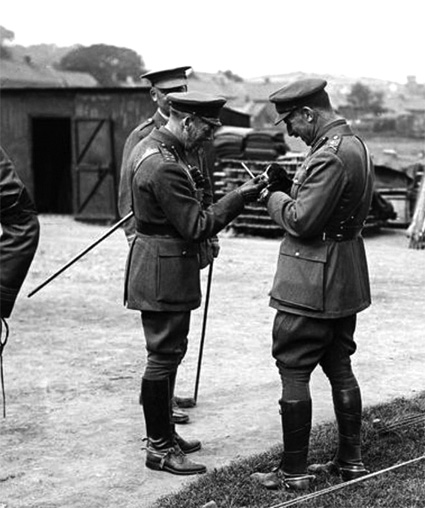The Remy Sidings was used throughout the war as base for several casualty 
clearing stations. Such was its importance it was visited by King George V
in 1916.
Charles Edward Garland Woodrow was born in Tottenham, London, in 1883 and was the son of Mary Ann Woodrow. When he was eight years old, Charles was living in Norwich as a boarder with Alice Harriet Jenkinson and her mother, Mary Ann. Ten years later, he was apparently living with his mother and grandmother in Thorpe St Matthews, Norwich, working as a brewer’s cellarman.
In 1904, Charles enlisted into the regular army, joining the 2nd Norfolk Regiment, having already served with the 3rd Battalion Norfolk Volunteer Corps. His time with the 2nd Norfolks lasted just over a year as, on 22nd August 1905, he was “Discharged; his services being no longer required.” It is likely that this was due to bad behaviour or persistent indiscipline. In 1911, Charles was back in Norwich employed as an attendant at “Heigham Hall For Lunatics”, a private asylum.
On 1st September 1914, just a month after war was declared, Charles enlisted into the Territorial Army, joining the 2nd East Anglian Field Ambulance. After only two days, his enlistment was cancelled due to unsatisfactory behaviour. Two weeks later on 16th September, Charles was back in employment, after joining the staff of St Audry’s Hospital as an attendant. Charles continued to work at St Audry’s until 27th July 1916 when he was called up to join the army. He first joined the 2nd Battalion, Suffolk Regiment and was later transferred to the 12th (Service) Battalion, Suffolk Regiment.
On 23rd September 1917, the 12th Suffolks relieved the 13th Yorkshire Regiment on the front line at Gonnelieu. On the 25th September, two companies, including Charles, who was a stretcher bearer, took part in a raid on the German line. The war diary contains just a single line to say what happened: “
At 7:30 pm we raided the enemy trenches bringing back 1 light machine gun and 5 prisoners.”
This did not tell the full story. The raid involved over two hundred and forty officers and men and commenced at dusk. The Germans quickly spotted the Suffolks leaving the trenches and set down a barrage of artillery fire. Despite the conditions, the men managed to reach the enemy trenches, where they bombed several dugouts, destroying the entrances to others before returning to their trenches. The hour long raid was not without a cost and the battalion suffered almost one hundred casualties.
A month later on 25th October 1917, the Woodbridge Reporter and Wickham Market Gazette contained a report:
“Meltonians will offer their congratulations to Private C Woodrow of the Suffolk Regiment who has been awarded the Military Medal for gallant conduct in the field. The General Officer Commanding in his own report states that: “Private Woodrow was a stretcher bearer during a raid on the enemy trenches on the night of 25th September last. During the whole time he displayed great courage and devotion to duty under heavy enemy fire. He made numerous journeys to the enemy front line returning with wounded.” Pte Woodrow at the time of joining the Army, was on the staff of St Audry’s Hospital, Melton.”
The Sidings – where Charles Woodrow died in 1918 – evolved into a village with wooden pathways and tended flowers
and vegetables in the gardens.
In March 1918, the German Spring Offensive started, with Charles and the 12th Battalion on the Somme. At the end of the month, they were transported to the Merville area on the Belgium border. On the 9th April, they were in support behind the front line at Fleurbaix when the enemy attacked with a heavy bombardment accompanied by gas in large quantities. Within a few hours, the battalion was involved in fierce fighting and later in the day, forced to retire and regroup having suffered a great number of casualties. Charles was wounded early on in the fighting and had been evacuated to a casualty clearing station at Remy Sidings, near Lijssenthoek, where he died from his wounds on the 11th April 1918.
Charles is buried in Lijssenthoek Military Cemetary and is remembered on the Thorpe St Michael War Memorial in Norwich and on the Melton War Memorial.
In addition to his Military Medal, Charles received the British War and Victory Medals for his war service.
